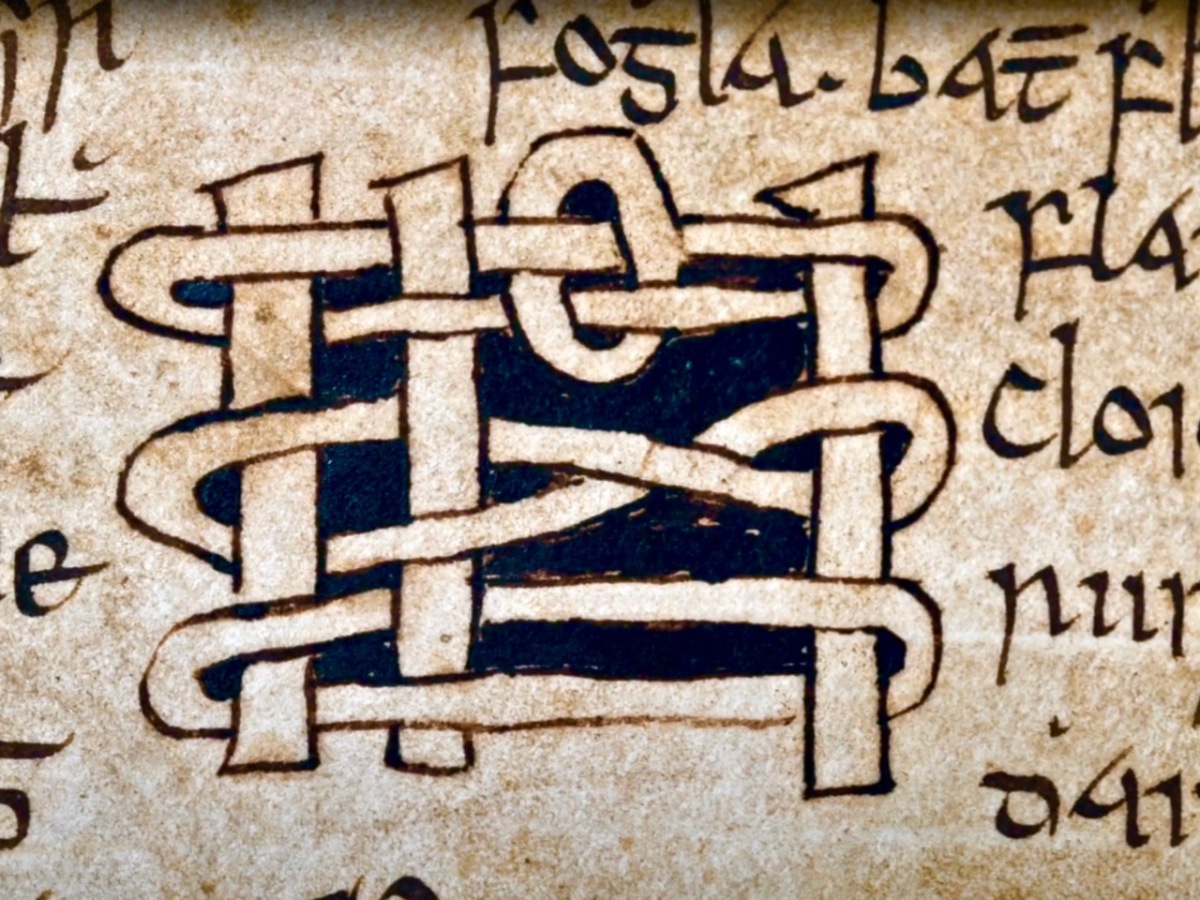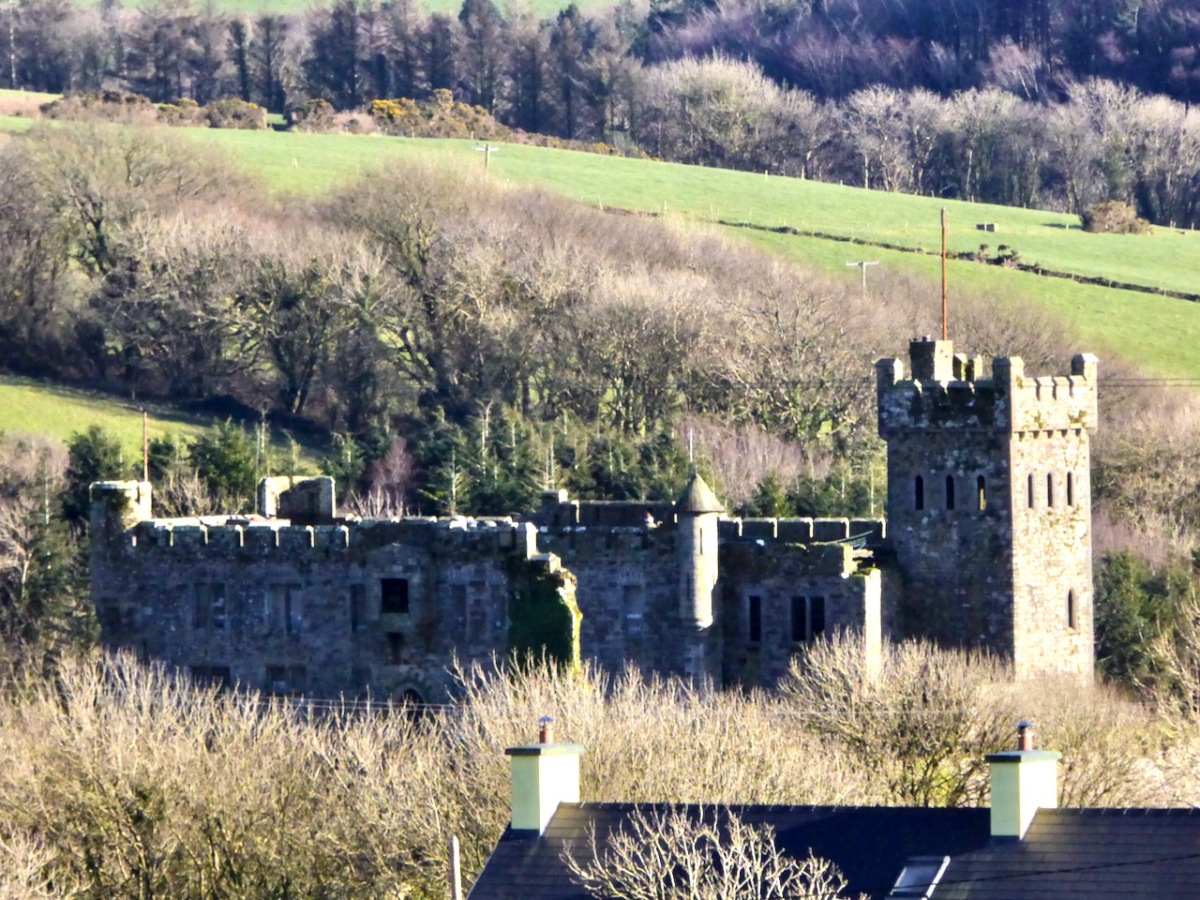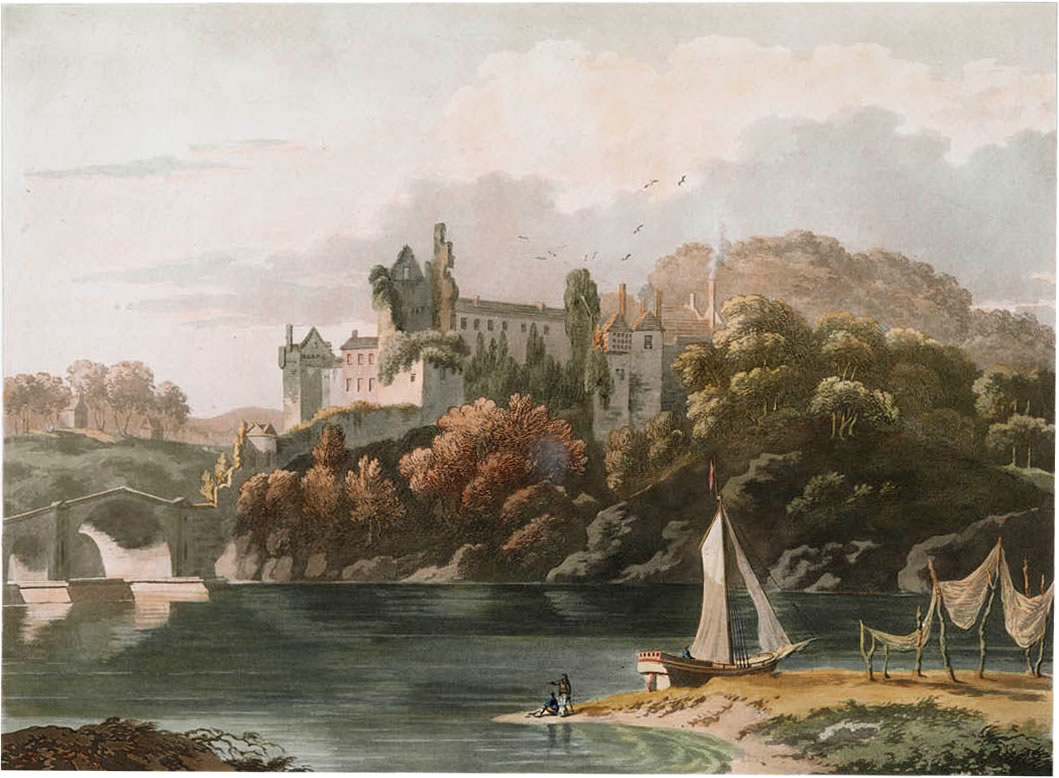
This is a topical post, as only this week we heard the news that the Book of Lismore has been donated to University College, Cork to become the centrepiece of the library there. It will be accessible to students and will contribute to the knowledge and study of Gaelic manuscripts dating from the 15th century.

When we think of ancient Irish manuscripts we might visualise the Book of Kells, which is on display in Trinity College, Dublin. It’s remarkable to think that the Book of Lismore is over 500 years old, but that the Kells manuscript predates it by 600 years: it was created around 800AD. Here’s a scribe (from Finola’s window by George Walsh) who could be from any of those medieval periods when monks and lay brothers worked away in their scriptoriums making, copying and illuminating beautiful works which have become our most precious historical documents:

The Book of Lismore is written on vellum, and was compiled for Fínghin Mac Carthaigh, Lord of Carbery (1478–1505) and his wife Caitlín. It became known as Leabhar Mhic Cárthaigh Riabhaigh. It is entirely in Irish. What has really excited us is that, in introducing the installation of the book at Cork, UCC Professor of Modern Irish Pádraig Ó Macháin mentioned our own locality:
[The book] belongs to a period of creativity which was centred on the coastline of Cork. It is difficult to imagine those seats of learning and literature today when you look at the remote rural landscapes . . . In Rossbrin Castle – the O’Mahony stronghold – translations, treatise and journals were being made using contemporary European resources: it was a proto-university in pre-urban Ireland, paralleled by the vibrant poetic tradition of the O’Daly family in nearby Mhuintir Bháire [The Sheep’s Head] . . .
Pádraig Ó Macháin, 2020 (paraphrased)

Rossbrin (above) was only one of many castles occupied by the Gaelic nobility along the coastline here in the 15th century and beyond: this ties in with my post of last week when I explored a 1612 map and identified many centres of occupation and scholarship which surely made West Cork so vibrant and cosmopolitan in earlier times. Books are known to have originated here – including the first to be written in Ireland on paper – and some of them survive to this day.


All the page illustrations in this post come from the Book of Lismore. It has a complex history and is likely to be by many hands. One – Aonghus Ó Callanáin – is certainly identified within its pages, and another – a friar named O’Buagachain is suggested. Tradition has it originating from the lost Book of Monasterboice and associates it with Kilbrittain Castle, Cork – reportedly the oldest inhabited castle in Ireland, dating from as early as 1035 and possibly built by the O’Mahonys – but also with the Franciscan Friary at Timoleague.


Upper – Kilbrittain castle in the present day: the original building is a thousand years old. Lower – the Friary at Timoleague, a foundation attributed to the MacCarthys in 1240, and plundered in the 17th century
The book fell into the hands of Richard Boyle, First Earl of Cork, during the Irish civil war in June 1642 and ‘vanished’ until its rediscovery in Lismore Castle in 1814. Apparently it was walled up together with the Lismore Crozier. By then the castle was owned by the Cavendishes, Dukes of Devonshire. It is this family that has donated the book to Cork and the nation, through the Chatsworth Settlement Trust.


Upper – Lismore Castle by TS Roberts, Aquatint and etching 1795 print by Samuel Alken. Lower – The Book of Lismore and the Lismore Crozier celebrated in this Celtic Revival stained glass window of St Carthage in Lismore Cathedral. The window is by Watsons of Youghal, and you can read more about them in Finola’s post here
One further thought: today is ‘All Saint’s’ – November 1st. The contents of the Book of Lismore include a section on the lives of the Irish Saints: these lives were translated by Whitley Stokes in 1890 and are available to read online. Finola has used this source in her post about Saint Fanahan, or Fionnchú. We look down on Rossbrin Cove and the ruins of the medieval O’Mahony castle – sometimes described as the greatest centre of learning in Europe! We feel excitement and gratitude that here in West Cork we are linked to this treasure from that age, now in the responsible hands of UCC.

This is great news Robert. Thank you for telling us of its interesting history and connection to West Cork.
LikeLiked by 1 person
Yes, we are very pleased, Gaia. We hope we can go and see it one day!
LikeLiked by 1 person
Looking forward to the day we can move about again and take in some of the country’s treasures. Yes Robert.
LikeLiked by 1 person
Great that its back in Cork. Reading it will be good practice for your Irish Robert !!
LikeLiked by 1 person
Sadly, Brendan, my Irish studies are suffering in these Covid times! I’ll have to get back to it…
LikeLike
One of the tales in the Book of Lismore is Forbhais Droma Dámhgháire, The Siege of Knocklong, which is available in translation here: https://celt.ucc.ie///published/T301044.html. It’s a fantastic tale involving Aonghus an Mac Óg, tthe King of Ireland, the King of Munster, the Sí, a deadly cattle disease, magic warrior sheep, a stone that transforms into a fighting eel, and the blind wizard Mogh Roith, who emerges from Valentia Island to fight a war of devastating spells with King Cormac’s druids. Great fun and a wonderful translation.
LikeLiked by 2 people
Great! I’ll read it over breakfast… Many thanks, Sean.
LikeLike
What a wonderful bit of Irish history. Thanks so much.
LikeLiked by 1 person
And thank you for reading us!
LikeLike
It is wonderful to have this treasure back in Ireland.
LikeLiked by 1 person
Agreed!
LikeLike
I smile at the terminology of ‘donation’ . Returned ?
It reminds me of a visit last year to the Viking Museum in Stavanger and reading about the ‘importation’ from Ireland of a fabulous gold piece of jewellery to Norway!
LikeLiked by 1 person
I know what you are saying, Pat. But the world needs to pursue positive thoughts and actions today. Surely far better than the alternative?
LikeLike
It is a remarkable survivor and wonderful to have it now accessible. It is a mine of information too and all with local connections.
LikeLiked by 1 person
If only we could look down on the scriptorium at Rossbrin and see into the past…
LikeLike
Amazing that this has survived in such good condition!
LikeLiked by 1 person
It has suffered a fair bit, Peter – there are many missing pages, poor repairs etc. Nevertheless it is a great asset to UCC.
LikeLike